#Budget travel guide Europe
Link
Love to explore new places? Visit The Eager Traveler today to get the best Travel tips & recommendations from experts! We will give you the right suggestions on travelling as per your fitness level, age or skill.
#Travel tips & recommendations#Backpacking guide for beginners#Destination guide Santa Maria Valley#Destination guide Carmel#Camping guide Joshua Tree#World travel guide#Thailand travel guide#Hiking adventures Washington#Best vacation destinations#Backpacking in Europe#California adventure tips#backpacking Southeast Asia#Female travel bloggers#Travel photography blogs#Europe travel blog#Travel blog & adventure news#Budget travel guide Europe
2 notes
·
View notes
Photo

(via Schengen Visa Fee Hike: What You Need to Know for June 2024)
#amit kakkar easy visa#schengen visa#visa fee increase#european travel#visa application tips#europe travel guide#visa requirements#travel budgeting#schengen visa fees
0 notes
Text
Discover Argentina: A Comprehensive Travel Guide
Brief History of Argentina
Argentina, the second-largest country in South America, boasts a rich history that spans from indigenous civilizations to European colonization and modern political developments. Before Spanish colonization in the 16th century, the region was home to various indigenous groups such as the Inca in the northwest and the Mapuche in the south. In 1816, Argentina declared…

View On WordPress
#adventure#Aeroparque Jorge Newbery (AEP#africa#Are credit cards widely accepted in Argentina?#Argentina#Argentina is generally safe for tourists#Brief History of Argentina#Buenos#Buenos Aires#cost of living in Argentina#Cultural Tours#destinations#Discover Argentina: A Comprehensive Travel Guide#Do I need to speak Spanish to travel in Argentina?#europe#Ezeiza International Airport (EZE)#Hiking#Iguazu Falls#Is Argentina a good destination for budget travelers?#kenya#Mendoza#Ministro Pistarini International Airport (MDZ)#norway#Patagonia#safari#Salta and Jujuy#Tango Dancing#technology#The cost of living in Argentina is relatively low#The Spanish colonization
1 note
·
View note
Text
#Travel Vlog#Travel#Budget Travel#Cheap Destinations#Travel Tips#Affordable Destinations#Travel Guide#Traveling on a Budget#Cheap Flights#Europe Trip#Wanderlust#Europe#Budget Destinations#Travel Hacks#Cheap Travel#Europe Travel Tips#Europe Vacation#European Travel#Explore Europe#European Countries#europe travel#europe#travel tips#where to visit in europe#top cities to visit in europe#europe travel tips#top places to visit in europe#travel guide#places to visit in europe#best places to visit in europe
1 note
·
View note
Text
Visiting Vienna on a Budget - What to See
Famously beautiful and famously expensive, Austria’s capital city of Vienna is rich with culture. Its massive palaces, baroque architecture, coffee culture, and musical legacy make it an appealing destination for visitors of all backgrounds- though some may find it a bit cost prohibitive.
Traveling on a budget, we had to find a balance between the luxury of the city and the lack thereof in our…

View On WordPress
#budget travel#Europe#things to do#Travel Blog#travel blogger#travel guide#Vienna#vienna on a budget#vienna travel guide
0 notes
Text
#a traveling treat#budget travel guide#how to save money for travel on a budget#how to save money on holiday travel#how to save money on vacation travel#how to save on a tight budget#How to Travel the World on a Tight Budget#how to travel to europe on a tight budget#live on a tight budget meaning#money saving expert travel#money saving expert travel abroad#money saving expert travel advice#on a tight budget meaning#safety of travel#save money before travelling#save money on food when traveling#save money on travel#save money while travel#save money while traveling#save money while travelling#saving on a tight budget#tight budget#tip for traveling#travel abroad by car#travel abroad cheaply#travel abroad money#travel abroad vaccinations#travel important things#travel on low budget#travel on Tight Budget
0 notes
Text
How I Traveled Switzerland On A Budget $500 Only

What's up, guys? I recently returned from a one-week road trip in the beautiful country of Switzerland I managed to only spend $500 on my week there, and I want to show you how to do the same.
Switzerland Budget Travel Guide
Switzerland is known as one of the most expensive countries in the world, it's so expensive.
It almost makes you mad, but I promise the beauty is worth the money and if you have a chance you need to go to Switzerland at least once in your life. So let's start.
With getting to Switzerland so for flights, you can find cheap flights to Zurich or Geneva I've seen anywhere from 400 to 500 dollars out of the states, but often it can be anywhere from up to a thousand dollars. I recommend if the flights aren't cheap, flying to a popular Airport in Europe.
Such as London or Paris where the flights are fairly cheap and then from there buy a separate ticket to Geneva or Zurich you can get those for anywhere from like 50 to 100 dollars. Once you're there, you need transportation.
The first option you can do is you can get the Swiss Travel Pass the Swiss trial glass is awesome it allows you to use trains buses, and boats all over the country it also allows you to use gondolas for free and other gondolas for half price.
For a three-day pass that gives you full access, it's about 250 American dollars, for an eight-day pass it will cost you four hundred forty dollars, not super cheap, but it's affordable, and it's great.
The second option I recommend and the option that I would prefer and this is what I did is renting a car you can get a car rental for fairly cheap, I rent a car for a week. It's great if you travel with a buddy, you can split the cost of a trip.
These websites, are where you can find great deals for rental cars or bikes.
QEEQ | AutoEurope | Economybookings | BikesBooking | Localrent | Getrentacar | Discover Cars
Trip Costs Breakdown
Car Rental: $200
Gas: $150/2
Lodging: $45
Food: $80
Entertainment: $100
Total: $500
Lodging hotels
In Switzerland is notoriously expensive, Airbnb, if you plan it right for 25 to 100 dollars per person in the high season, might be a little more expensive than that, but that is affordable if you're with somebody.
You can split that cost I and my friend need we actually found a lodge in the mountains of pins L, and we spent the night there for $45. And which included breakfast it was awesome, there are cheap options for lodging if you plan it out all right.
Food
You don't go to Switzerland for the food you go there for the beauty, the food is so expensive there almost makes you mad if you want a good meal at a restaurant it's going to cost you forty to sixty dollars.
What I did is I went into grocery stores the two main grocery stores are coop and Migros and while most of the stuff is fairly expensive there you are able to find good deals and stuff and there are a lot of things that are actually cheaper there than they are in Morocco.
For example chocolate, you can get nice brown chocolate for 50 cents you can get a pound of pasta for a dollar to be able to make it they also have pre-made kinds of pasta and salads for like two to three dollars there are cheap things in the story.
Stay away from restaurants if you want to save money, all right so the last.
Entertainment
On the list are entertainment gondolas special train rides and other activities. It can get very expensive, it's typical for a gondola to cost anywhere from thirty to a hundred dollars. That's a lot of money.
With the Swiss Travel Pass, you can get free gondola rides and others are going to be half of what I recommend if you want to save money. Just plan out on doing one or two on the trip.
You can hike, this is what I didn't Grindelwald I did not want to pay $60 to take a gunner off the mountain. I saw a mountain peak I wanted to hike – hike straight up the mountain, and it was awesome. I had the whole place to myself and I had a wonderful experience.
Just gotta decide if you want to splurge or not, that is entertainment.
That is my Switzerland budget travel guide, Hope you guys enjoyed this.
#travel europe#tourism#nature#travel#trip#vacation#travelling#europe#germany#european union#western europe#france#switzerland#budget#adventure#travel guide#travel backpack#travel tips#travel blog#travel photography#travel destinations
0 notes
Photo

New Post has been published on https://ourbigescape.com/ultimate-finland-travel-guide/
Budget Finland Travel Guide 8 Ways to Save More Money
The Budget Finland Travel Guide includes 18 Important Travel Planning Tips that will allow you to see and do more on your budget. Learn how you can benefit.
Welcome to the Finland Travel Guide! If you are one of those people who truly loves exploring the great outdoors then Finland must rank among the finest countries in Europe to visit. From the natural splendor of the Northern Lights and Hossa National Park through to the buzzing culture of big city Helsinki, you’ll have no difficulty filling up your itinerary whichever way you turn.
Make no mistake – there is a huge amount to see in this splendid country and you’ll be surprised that a country famed for its wilderness has so much unexpected diversity, and a cultural history steeped in an age-old tradition.
Finland may be a little off the ‘beaten path’ for many visitors to Europe, and perhaps that explains why the country remains so unspoiled and unique. Thanks to the convenience offered from a modern transit network and a bewildering ability for keeping trains running on time to the minute in blizzard conditions, Finland is surprisingly easy to explore. Those who do opt to explore something a little different are going to be guaranteed a quite unique experience that may well prove the most memorable of any European tour.
What Are the Best Places to Visit in Finland?
Lapland is far more than the home of Santa Claus (‘Joulupukki’ in Finnish) and while you’ll find no shortage of opportunities for photos with the great man, most visitors will be looking to enjoy some of the most staggeringly beautiful sub-arctic wilderness in the world. As you may expect the majority of activities throughout the region focus on the outdoors – and we’re talking way more than your typical snowsports. Reindeer and dog sleigh tours are fantastic ways of experiencing this side of the country (and don’t worry – the animals are magnificently well cared for).
You should, of course, be watching for the eponymous Northern Lights throughout the day and night. These are possible/very likely anywhere in Lapland from September through to April although are best around Christmas and New Year. Some people – including us at the Finland Travel Guide – reckon that thanks to near-zero light pollution that they are the best Northern Lights in Scandanavia (just don’t tell the Norwegians or Swedes!). Rovaniemi has perhaps the best reputation for being ‘guaranteed’ to see the lights, but we found the quality was better at Kakslauttanen thanks to being that little bit more remote.
Finland is famous for its tens of thousands of lakes – and a huge number of little castles and fortifications that tend to be dotted around them. Just by strolling aimlessly about the Oulanka, Nuuksio, Urho or Koli national parks you’d be sure to stumble across them by the dozen – but that is certainly not recommended! When the Finland Travel Guide says wilderness we really do mean it.
While there are plenty of well-walked routes with a good mixture of difficulties and lengths, you just need to venture a little away from the more traveled paths and find yourself in near-total isolation. If you are heading from some ‘proper’ hiking then make sure you have the right gear and some understanding of basic fieldcraft and navigation.
You’d be forgiven for thinking that Finland was all about traipsing through the wilds, and while that ought to be a key part of any visit, there is plenty else to see in towns and cities found mostly towards the southern and eastern ends. Helsinki is an excellent city to visit not just because it has the Suomenlinna park on its doorstep but because there is also plenty to see in the city itself.
It is particularly good for walking/cycling tours (highly recommended) so make certain to see the Temppeliaukio Church, Uspenski Cathedral, Sibelius Monument, and other national sites. When you cannot stomach any more culture, check out the Töölönlahti Bay for some amazing seafood or maybe relax on the Hietaranta beach (yes Helsinki has a beach!).
Most people will arrive and depart from Helsinki and then travel onwards further north without taking the time to visit much of the central regions. As with any European country, it can be as straightforward or as spontaneous and unexpected as you choose.
Much of Finland receives very little in the way of regular tourism – certainly less than neighboring Sweden – and you should expect a level of authenticity that can be quite rare to find elsewhere. Turku Castle towards the Russian border is a fascinating place steeped in many centuries of conflict, while the Åland Archipelago is perfect for exploring by boat (and a handy way of getting over to Stolkholm to continue your travels).
What Are the Best Things to Do in Finland?
Finland is a kinda handy country to tour because you tend to go to specific regions for particular activities. The iconic experiences such as hiking and sledding through the wilderness are basically all there is to do in the northern Lapland region besides the occasional museum and staring in amazement at the Northern Lights. You could pretty much ‘experience’ the region with just a handful of days, or you could take a serious hiking expedition that may last for weeks.
Much of the same can be said for the lake regions and all of the national parks. If you are interested in exploring and really experiencing what it is like to be in the middle of nowhere then Finland is a fantastic place for doing so with paradoxical ease.
One experience that your correspondent from the Ultimate Finland Travel Guide loved far more than anticipated was staying for a couple of nights in one of the more famous Ice Hotels. You’ll find similar examples in the other Scandi countries and in North America, but for the convenience of the uninitiated, they are surprisingly luxurious and deceptively warm!
Best of all is that they tend to be remodeled every year – whoever knew how easy it was to cut huge chunks of ice so elegantly? It is the perfect way of enjoying a chilled Finnish vodka martini in the comfort of your hot tub!
Santa is – needless to say – a big draw especially with one/two-night trippers from other parts of Europe (especially the UK and Germany for some reason). Fortunately, it hasn’t become grossly over the top and there is a good amount of tongue in cheek joking between which version of Santa is the real one – the white-bearded old man, or the mythical and slightly creepy goat.
We’ll let you make up your own mind, and the good news is that commercialism is there to enjoy if you like it – or you could easily turn the other way and enjoy natural splendor. Whoever said variety was a bad thing?
Helsinki is pretty small for a capital city (about 600,000 from a national population of 5.5m) but has a thriving contemporary and classical art scene, plenty of festivals across the calendar including the ‘world-famous’ Air Guitar Championship… In all seriousness, it is very reminiscent of Rekjavik and Gothenburg in the way that it focuses very much on delivering high quality produce/shopping at often quite high prices. Check out the various museums/galleries when you have the opportunity – the Ateneum, Sinebrychoff Art Galley, Finnish National Gallery, and several smaller residences are well worth the time and invariably serve amazing quality coffee.
So while it can be straightforward to pigeonhole Finland as an outdoors country there are plenty of alternative sites well worth taking the time to explore. Despite Helsinki being towards the pricier end of the scale, it has been attracting many more ‘in the know’ visitors in recent years who are put off by the often unseemly crowds you’ll find at many of the nearby Baltic capitals. Helsinki is a cool city and one that thankfully still has not been in the slightest bit defiled by mass tourism.
When is The Best Time to Visit Finland?
Hopefully, you are by now a little tempted to give Finland a try – and here is where deciding what time of year to visit is going to really matter. Depending on what you want to see/explore there are very different opinions on what constitutes high, low and shoulder seasons in Finland. For this reason, we’ll roughly distinguish by experiences instead of the time of year.
Should you be interested in camping and hiking through the central and coastal regions, and most people are, then July/August is the time to visit. You’ll have no problem finding plenty of cruises to compare, accommodation can be surprisingly cheap (or at least open!), and most of the large festivals occur around this time of year. Remember that many Finnis tend to take their annual vacations in the winter to enjoy snow sports, or to simply flee the country for more gentle climates!
But we at the Finland Travel Guide are not put off by a little frost. Aurora hunting is best over the winter months (especially either side of Christmas) and you’ll enjoy proper winter wilderness. Days are short, hotels are often closed, and those which are open cater mostly for skiing at pretty steep prices. Hiking is not likely unless you really know what you are doing or are willing to take a guided expedition. If you are determined to see the Lights and experience Finland as it is best known, then this is the time to visit.
Shoulder season is probably the best time if you intend on spending a lot of time outdoors and wish to enjoy a mild climate and not too many insects in the northern regions. Again, you need to plan a little for some attractions being potentially closed or in refitting, although the major museums/galleries ought to be open. Watch out for Midsummer – the whole country has a party for a weekend and basically everything closes down. Fantastic if you are already in the country, not so much if you are looking for a running train or an open attraction!
GOVERNMENT LINKS General Information
VISAS
Tourism
Do I Need A Tourist Visa in Finland?
You really should have no problems whatsoever gaining entry into Finland. Those from the majority of Western countries (Including the USA, UK, NZ, Australia, Canada, and EU nationals) can stay for 90 days out of 180 consecutively. Anyone else – including visitors from South Africa, China, and India – will need a visa.
Expect no trouble passing through immigration providing your documents are in order. Visas are usually issued quite promptly where needed but you must apply and be approved before arriving.
Colorful evening scenery of the Old Port in Katajanokka district of Helsinki, Finland
Do U.S. Citizens Need A Visa for Finland
U.S. citizens do not need a visa to enter Finland, which simplifies entry into the country; however, a passport valid for at least six months past the planned date of departure is required.
What Currency Is Used in Finland?
Finland uses the Euro (€) that exchanges for around US$ 1.11 at the time of writing the Finland Travel Guide.
You will have absolutely no problems using cards for payment pretty much anywhere in Finland. Even the smallest stores and cafes will 99% of the time accept credit/debit card payments providing you have a four-digit PIN-enabled account. ATMs are still absolutely everywhere, should offer English language options, and do not charge any processing fees (although your banking services provider most certainly will).
The majority of visitors to Finland will get by just fine with a token amount of cash for small purchases and by using cards for everything else. If for some reason you need a bundle of cash then make sure to use banks for the best exchange rates. Note that the Finns are so invested in card technology that Traveler’s Checks are pretty much consigned to the history books nowadays and very few places will change them.
Do I Tip In Finland?
You will not be offending your server by not leaving a cash tip – it is almost universally added bills automatically (including hotel room charges). Only feel inclined to leave a tip for truly exceptional attention. Tipping is not customary for taxi drivers or bartenders although once again it is entirely at your discretion.
What Kind Of Budget Do I Need In Finland?
While Finland has a reputation for being an often surprisingly expensive country to visit the reality on the ground is somewhat different. It is perfectly achievable to explore Finland on a tighter budget than what you may expect, although you are inevitably going to be restricted by price constraints on what activities you can afford.
For instance, a hiking and camping tour of Finland during the summer is not going to break anyone’s bank. However, a ‘winter wonderland’ stay in the North during the peak Aurora chasing times of the year with incidental reindeer sleigh rides is going to become expensive very quickly. So with those caveats in mind here is a rough approximation on what we at the Finland Travel Guide would suggest visitors should expect from their budgets.
Budget (€100/day)
Hostels are universally good quality in Finland and visitors certainly benefit from the fact that the country is not actually known as a budget destination. You should look to book ahead in the summertime but that is really just to make certain your bed is secured – we have rarely struggled to find a place anywhere. A smart dorm bed with the expected conveniences will cost about €25-40/night depending on location and season. Campsites can easily be half that rate, but of course, you will be restricted to summertime and shoulder seasons.
Daily costs are where prices start to become noticeably expensive. There are always budget-conscious options from shops, takeaways, and food stalls but you’ll be looking at about €20+ for a single course meal at any seated restaurant. National museums are usually free but others will charge pretty steep admission rates comparable to what you’d expect in Paris/Berlin. We’ll cover travel costs shortly but on a budget, you’ll be advised to take a look at buses compared to the much more expensive train network.
As with many countries where the key attraction is unspoiled and natural beauty, providing you keep an eye on your expenditure you can enjoy a really good time in Finland without spending a huge sum.
Mid-Level (€200/day)
We’d compare this kind of budget to what you’d expect to pay in Sweden. Broadly speaking the prices for accommodation and travel are very similar, with double hotel rooms most likely going to be the largest daily expense. You should anticipate about €100-120/night for a basic yet modern hotel room. Factor in that price tends to be lower at certain times of the year and that the wilder/remote regions will usually be considerably more expensive.
Even though rooms are expensive assuming you are splitting that cost for a double there is still a fair amount to ‘play with’ on this budget. You could stretch that a little and take some sleighing trips, perhaps even a little cruise around the islands, and still not massively go overboard (so to speak!). Consider your dining options with some degree of care. Eating out is often reserved for very special events throughout the Scandinavian countries and you’ll notice this reflected in the high prices. Even a cup of coffee and a slice of cake in Helsinki can stretch beyond €10.
On the plus side, while museums and galleries are prone to charge admission they will not be much of a problem on this budget. Car hire is feasible if you are sharing as a group (€50/day) although fuel is very expensive. Generally speaking, you ought to take this kind of budget and look for the best way of applying it to the sort of stay you are looking for. If you want wilderness, then spend more on special retreats and lodges which are expensive but tend to include meals and subsidized tours/expeditions. If you are in the city, compromise on your hotel and spend big on the nightlife, shopping, and outstanding restaurants.
High-End (€300+)
You can spend your entire daily budget on a top of the range hotel room on this kind of budget – and would be right to expect something very boutique, trendy and most certainly upmarket! Throw in about the same again if you want to enjoy a meal at one of Finlands top restaurants – the prices on the wine lists are comically high, so consider that an adequate warning.
Joking aside you can enjoy pretty much all the best of Finland on this budget. You most certainly can enjoy the natural splendor, but rather than retreating to a campsite for the evening why not go ‘glamping’ at kitsch and cozy 5-star alternatives? Definitely take the opportunity for a sleigh ride, and who knows – maybe even a personalized trip to see the Santa of your choice.
Those with money to burn should perhaps consider midsummer providing you can find a hotel room. they book out sometimes years in advance assuming they choose to stay open at all. All of the Nordic countries have their own versions, and the communal festivals are incredibly welcoming to outsiders.
Overall, while it most certainly helps to have some cash when visiting Finland you can still enjoy plenty of the best in the country without spending crazy money. From a budget travelers’ perspective, you will need to think a little outside the box if you wish to enjoy key attractions such as the Northern Lights. Perhaps look for Airbnb options in popular areas that may offer better value compared to hotels. Or simply book one of the every limited hostel places in the northern regions far in advance. However you choose to approach it, the more effort put into experiencing something that amazing the better the experience is going to be.
Cozy wooden cottage in dark winter forest
What Languages Are Spoken in Finland?
Finnish is the language you’ll hear the most but Swedish is also an official language in Finland. From a visitor’s perceptive it is unlikely to make much of a difference – pretty much all Finns will speak English to an impressive standard with about 40% of the country at fluency standard. Lower proportions speak German as a second (or third/fourth/fifth) language.
It is worth knowing that despite the above, around 10% of the Finnish population – mostly those residing in isolated regions – do not speak any conversational English.
Do not feel awkward about approaching Finns to ask a question and speaking immediately in English – providing you do so politely. Finnish is notoriously difficult to learn and none of the locals will expect more than a simple “anteeski” (excuse me) first.
What Religions Are Practiced in Finland?
About 72% of Finns are Christian (almost all Lutheran), 24% specify no religious beliefs whatsoever and the remaining makeup tiny pockets of Islam, Buddhism, and others. As you may anticipate the Lutheran church enjoys a special status as the ‘official religion’ of the country even though it has little in the way of actual administrative power. It is quite paradoxical that even though Finland has encouraged freedom of religion protected by law since 1923, they are one of the least diverse religious countries in Europe.
Visitors to the country will not really notice any religious undercurrent unless they wish to participate. Religion is a factor in some people’s lives, but Finns are quite a socially conservative bunch and tend not to discuss such matters with strangers. You will find little in the way of evangelicism or more vocal denominations.
Practical Tips From The Finland Travel Guide
Now we have covered the basics for what anyone ought to expect from visiting the country, we’ll now shift our attention tot he simple practicalities of making the most of your stay. We at the Finland Travel Guide are not kidding when we claim that despite the reputation for being expensive and tricky to navigate, you can really explore this country without spending beyond your means. Just like Sweden and to a lesser extent Norway, the savvy traveler can have a wonderful time in this gorgeous country despite living from hand to mouth. You just need to think a little and make some compromises here and there.
Something you may have heard during your research into Finland is that they aren’t really the most ‘touchy-feely’ of people! There is an element of truth to this. Finns are really not people who tend to perform small talk, and attempting to speak to a stranger on a casual basis – for instance, commenting on the weather – will likely be met with a degree of bafflement. Obviously, that is not true for everyone but it is something which can incorrectly present a rather stubborn attitude towards visitors.
Their rivalry with Sweden has existed for hundreds of years, and their animosity towards Russians still ranks pretty deep among older segments of the population. Finns have struggled for many generations to achieve and maintain their freedom, which does, to a degree, foster a kind of insularity that can be misinterpreted as impoliteness or even hostility. They aren’t really like that. Just be careful to mind/appreciate personal space, avoid eye contact, be exceedingly polite and keep your voices down and you’ll be fine!
You’ll find the best way to engage in conversation with strangers in Finland is either in the sauna or in the bar. Those are socially acceptable places to discuss sporting events and suchlike in a casual manner. People will want to be your friend really!
Finland Bright colors of summer.
What About Health and Safety in Finland, Is It Safe?
Finland has one of the lowest general crime rates in Europe and violent crime is extremely rare. Visitors are unlikely to be specifically targeted and even petty crimes such as bag theft and pickpocketing are practically unheard of. You’ll be extremely unlucky to fall victim to any crime in Finland.
Your biggest risks to personal safety are going to be from approaching the wilderness without proper equipment. It ought to go without saying that apart from the summer you will need some degree of warm clothing, plus adequate tents and so forth. There is dangerous wildlife (bears, wolves, etc) in Finland but they will stay far away from people. You are far more likely to crash a car into a moose – lookout for the roadsigns – than even sea a bear or wolf. Keep an eye out for hypothermia or frostbite in the winter, and mosquito bites in the summer. The latter is more a nuisance than a risk.
Moving on to healthcare, Finland has some of the best medical care in the world and you’ll be in good hands if you are injured or fall sick. EU citizens should apply for and carry an EHIC before visiting Finland to enjoy free/massively subsidized costs. You may still require special insurance if planning on skiing or taking on more extreme winter sports.
Visitors from elsewhere are going to need comprehensive insurance cover. Remember to make copies of prescriptions and any essential medical notices, ideally uploaded also to the Cloud for immediate retrieval if required. You may need to visit a Finnish doctor for reissues of prescriptions and accept that available brands may vary compared to what you are used to.
You should not require any particular vaccinations before you visit. The Finland Travel Guide can gladly attest that Finnish tap water is not only universally safe to drink, but is also the best tasting in the world.
What is the Best Transportation in Finland?
Finland enjoys an excellent train network that should be good enough for most visitors. Tickets can vary in price depending on distance and classification. Express trains are, as you’d expect, faster and more expensive than slower regional services. Ticket prices vary from expensive through to pleasantly affordable providing you book in advance online (at least 24 hours, ideally much longer). The problem is that the further north you head the more limited the network becomes. Just like Sweden, Finland is deceptively long and narrow and journeys can take much longer than you’d anticipate.
Buses are available on a wider network and in some ways are a better option than the train. Tickets are cheaper, and considering the long distances, the buses themselves are clean, comfortable and modern. Note that Finland has a relatively low-speed limit so expect longer journeys to take up a good chunk of a day.
Most Finns would opt for the bus compared to the train because while offers exist for both the bus has a better variety of discounts especially for younger people and seasonal passes. If you are visiting on a budget then the bus is certainly most likely your best bet for saving on costs while also taking in some pretty impressive scenery.
Note that some services do not run in winter so check well in advance. If money is not a problem and/or you are part of a group, car hire is pretty good value, roads are high quality and invariably cleared of snow around the clock. Just remember that gas prices are some of the highest in Europe.
Ferries run routinely throughout the year out to the islands and back over to central/eastern Europe. Domestic services can actually be a great way of exploring the western areas for decent prices, and certainly far cheaper than an organized tourist cruise which would take the same route anyway.
Internal flights are a valid option from getting between Helsinki and Lapland, just be sure to check availability according to the season you intend on traveling. As you’d anticipate, tickets are extremely expensive in peak season and often fully booked out well in advance. Discounts are rare on any internal route.
Beautifully decorated Christmas house
What Are the Best Accommodations in Finland?
Hostels – where available – are the visitor’s best friend when hoping to explore Helsinki on a budget. As a rough rule, accommodation prices are very similar to other Scandinavian countries. Hostels are excellent quality and at about 30 Euro a night are a comparative bargain. Expect to pay four times that for a very average hotel room. High-end accommodation will be at least 200-300 Euros per night and possibly even more for a room that, at the end of the day, is just somewhere to sleep. As ever, the choice is yours.
The Finland Travel Guide suggests that all visitors to this country look at alternative accommodation options besides the typical hostel/hotel conundrum. Finland is an extremely on-line country and you’ll have no problem finding people with spare rooms or even full apartments to let out on a casual basis. For those visiting areas with a more limited choice in ‘traditional’ accommodation then you really ought to consider this as a way not only for saving cash but also as an avenue of getting to known Finland a little better.
In the summertime, the climate is pretty much ideal for hiking and camping. Sites can book out for the more popular spots, so book in advance and pay attention to rough camping laws/restrictions. They can vary depending on your region. Should you opt to camp, expect to find excellent facilities and quite possibly the option for a chalet costing a little more than a standard hostel private room but capable of sleeping four people or so.
How Can I Practice Responsible Tourism in Finland?
Should you be lucky enough to explore Lapland it is essential that any responsible visitor does their best to invest in the indigenous Sámi run services. A good proportion of the best reindeer routes and more interesting Kota (tee-pee) accommodation options are going to be run by these people. Apart from these kinds of businesses they have little other income, so far better to share your money with them compared to some anonymous international hotel chain.
Protecting the natural splendor of Finland is paramount in the tourist industry and a major reason why the country is nowhere near as involved in self-promotion and marketing than it arguably should be. Getting to Lapland is not especially easy – and that is not just due to limited numbers of visitors, but also because of government pressure to keep the environment as unchanged as possible.
Wherever you go in Finland you ought to make sure you leave no trace. That includes campsites and firepits just as much as it does litter and waste. You are free to camp in many areas of the country providing you do so responsibly. Punitive fines are in place should those rules be broken.
Keep a low ecological footprint wherever you go, buy local, and understand the sensibilities of the locals and you can consider yourself a responsible visitor to Finland.
What Food Should I Try In Finland?
Attempting to pronounce classic Finnish foods is only a small part of enjoying how good they can be. There are plenty of national dishes that you’ll find cooked on a regular basis in people’s homes, although for some you may need to visit more specialized restaurants. Here is a selection of the Finland Travel Guide favorites.
Karjalanpiirakka (Karelian pies) is a common ‘working meal’ that is very similar to an English pastry. The usual course pastry is filled with a selection of stewed potato, rice, carrot, and sometimes with added meats and eggs. Handily pocket-sized and packing enough energy to last through the most bitter of winter afternoons, these are a real delicacy that is sure to keep you going.
Ruisleipä is without any doubt the best rye bread that you’ll ever eat. It is taken with pretty much every meal regardless of the restaurant status, and at home is baked in long rings which are hooked to the ceiling for storage. You’ll still see these in pretty much every baker’s shop and once more they are ideal for the penny watching visitor.
Silli Ja Uudet Perunat (herring with new potatoes) is a dill packed national favorite that you’ll find served especially during midsummer festivals. Discussing the merits of various potato is a peculiar Finnish obsession…
Christmas house in official Santa Claus Village in Rovaniemi, Finland.
What Should I Pack for A Trip to Finland?
Try not to forget any essentials when packing for Finland as while replacements are never going to be difficult to find, they can be extremely expensive! Pack suitable outdoors wear for any season, ideally featuring plenty of layers that can be added or removed depending on the weather. A lightweight waterproof item is a good idea despite the mild summers, whereas a good warm hat and overcoat are pretty much essential in winter. Make sure your boots are in good order and properly waterproofed.
Other than those basics you should not need anything else when visiting Finland.
What Clothes Should You Wear In Finland?
Despite the reputation for being a bit conservative and prudish – which we’ve tried to account for and dispell throughout the Finland Travel Guide – you’re best off dressing to conform in this country. Nobody will challenge you for being scruffy unless you are also wearing something offensive or inappropriate in particular locations. A responsible visitor will not be intending to cause offense anyway, so best reign in the more extreme dress senses during your visit to Finland.
You’ll notice that Finns are quite affluent yet still dress in a pretty unconventional manner. They’re ones for discreet classiness, and that fact ought to be remembered at more upmarket restaurants and so forth.
Castle Olavinlinna (Olofsborg) in winter, Savonlinna, Finland
What Are Some Interesting & Important Facts About Finland?
We are nearing the end of our Finland Travel Guide and hope you have found this a useful introduction to one of Europe’s most beautifully unique countries. As with any country, you will visit, places and people are always going to have some interesting differences and Finland is not any exception to that rule.
Despite their reputation for being a little more clinical than some of their more extravagant European neighbors, you’ll discover plenty of fun and interesting facts while touring this country. After all – it’s always the quietest ones who tend to have more bizarre points of interest! So here are a few little facts to get you started with exploring this fascinating nation.
▸ According to the United Nations, Finland is the happiest nation on Earth (perhaps they just don’t complain enough).
▸ Alongside the world air guitar tournament, Finland is also the global capital for the world wife-carrying championship.
▸ Finland has an annual day to celebrate their failures – October 13th.
▸ Finland no longer has a single public payphone.
▸ Each Finn consumes on average 12kg of coffee per year.
▸ Finland operates unlimited fines for speeding on the highways (told you they drive slow for a reason).
▸ Perhaps that explains why they have more saunas than cars.
▸ Heavy metal is the unofficial national music of Finland
▸ Finland was the first European country to enact Universal Suffrage (allowing women to vote).
▸ They consume more salty licorice than anywhere else on the planet.
We hope you enjoyed reading the Budget Finland Travel Guide – and good travels! Contact us with any questions you may have about travel to Finland.
Now that you have read the Ultimate Finland Travel Guide, what’s next? Let’s go next door to Norway. Check out The Ultimate Norway Travel Guide
0 notes
Text
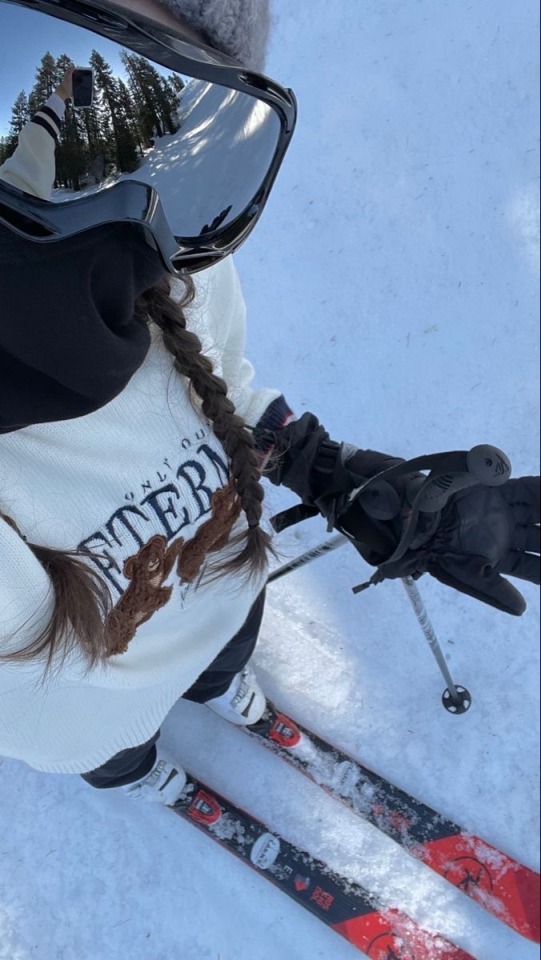
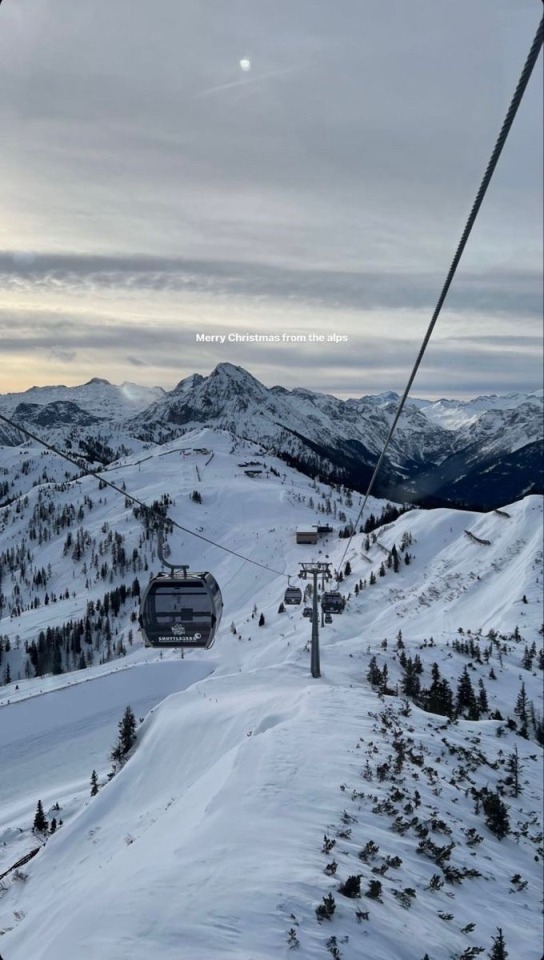

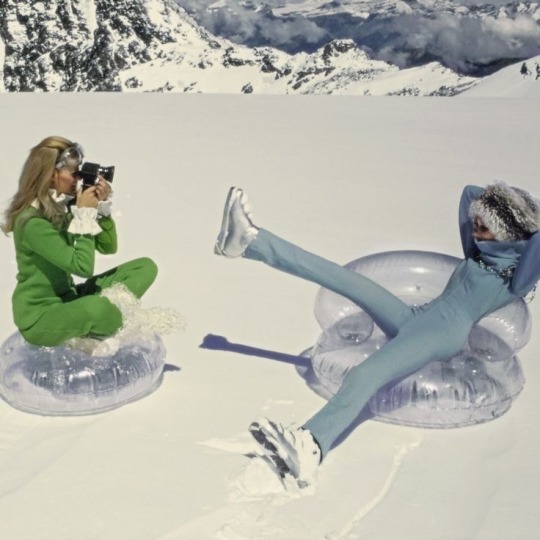
Skiing - a beginner’s guide
I first went skiing in Switzerland with my friends nearly 10 years ago and I loved it. The feeling of the wind on my face, the speed, the adrenaline- it was exhilarating.
I’ve compiled a basic list of ski events, a semi-scandalous article and some of the best destinations in the world as well as some budget friendly ones.
Socialite ski events:
Snowboxx:
Since it launched in 2013, winter festival Snowboxx has been growing in popularity - and it involves flying out to the Alps for a week-long ski party. It takes place in Avoriaz ski resort, Morzine, France each March, and this year saw a superstar lineup of artists performing in the mountains, including ex-Radio 1 DJ Annie Mac, Becky Hill, Jax Jones, Sonny Fodera and Andy C.
The combination of partying to some of the world's best DJs, with the unusual day-activites of skiing and snowboarding, are making many turn away from the summer festival circuit in favour of the winter one.
Hahnenkamm, Kitzbühel , Austria:
The Hahenekamm ski race weekend in Kitzbühel is arguably the biggest alpine ski event in the world. The world’s best take on the iconic Streif downhill track, which is historically the toughest ski race track on the World Cup circuit. A lot of the speed skiers consider winning races here as a bigger honour than the Olympics. As a spectator, the atmosphere is electric with fans around the world admiring some breathtaking ski racing.
X Games, Aspen, USA:
The world’s best freestyle skiers and snowboarders compete annually in Aspen. The event is a prestigious honour to win amongst action sports athletes and has propelled careers. Spectating the event is excellent because you can see most of the action from the viewing areas. The halfpipe events in particular are excellent to watch for this reason.
European Snow Pride, Tignes, France:
Tignes is home to Europe’s biggest gay ski week, with the European Snow Pride. Each day has a theme with nights of brit-pop to superhero days. Many international DJs are invited to play each evening party in the resort’s local clubs and bars.
Slightly scandalous tales: Things I Never Knew About Skiing Until I Was a Private Instructor in Aspen
Really interesting read. I was thoroughly entertained.
Popular ski destinations:
1. Whistler Blackcomb, Canada
Whistler makes it onto pretty much every ‘World Top 10’ list when it comes to ski resorts
2. Niseko, Japan
Located on the northern island of Hokkaido, this Japanese skiing destination is a snow-covered paradise. With a huge 15 metres of average snowfall, it’s no wonder that Niseko is the country’s premier ski resort.
3. Zermatt, Switzerland
As the highest resort in the Alps, it’s got the views. The incredible peak of the Matterhorn can be seen from just about anywhere on the slopes! It also boasts the greatest vertical drop in Switzerland, and there’s all year round skiing at the Matterhorn Glacier.
4. Courchevel, France
The resort is a part of the world’s largest alpine ski area, offering more than 600 kilometres of terrain and interconnected ski runs across 10 summits. The snow here is well-groomed, and there’s a legendary black run that’s considered to be one of the trickiest in the world.
5. Cortina D’Ampezzo, Italy
Known only to the most dedicated, well-travelled skiers prior to the 1956 Winter Olympics, Cortina is a hidden gem in Italy’s Dolomite Mountains.
6. Baqueira-Beret, Spain
It may be a surprising destination for skiing, but Baqueira-Beret in Spain is one of the best places in Europe where you’ll find value for money for a ski holiday. You’ll be able to find affordable accommodation as well as some of the finest tapas restaurants in the country.
7. Ylläs, Finland
The arctic landscapes of Lapland are perfect for skiing. If you dream of snow-dusted trees, the magic of the Northern Lights, or the glow of the midnight sun, Ylläs is a unique winter resort that you won’t want to miss. As Finland’s largest ski resort, it’s got everything you need.
Budget friendly destinations
1. Vogel, Slovenia
An ideal spot for couples or families, this Slovenian spot is a truly beautiful and peaceful ski area. Overlooking Lake Bohinj, Vogel is part of the Triglav national park.
2. Livigno, Italy
Duty-free zone Livigno offers excellent slopes for intermediate skiers. But advanced skiers and snowboarders will be kept busy too – especially if they’re keen to explore off piste.
3. Poiana-Brasov, Romania
Poiana Brasov is Romania’s biggest mountain resort and certainly one of the nicest. The fairytale slopes, flanked by pine trees, are the perfect place to take your skis. With more than 24km of ski runs, there’s plenty to explore.
4. South Korea -Muju Deogyusan Resort
Muju Deogyusan Resort in Jeolla province is only 3 hours away from Seoul. So, if you want to spend your holiday skiing and still enjoy the city of Seoul, this is the place to go.
5. Niseko Ski Resort
Located in Hokkaido, Japan, Niseko Ski Resort boasts a total of four different resorts but with linked ski area. A single pass would give you access to all four resorts. One of the resorts, Mt. Resort Grand Hirafu has been officially named as Japan’s number one snow resort due to the wide array of activities offered.
6. India - Gulmarg
Gulmarg is a rare gem in the Himalayans that will undoubtedly take your breath away with its picturesque beauty. However, skiing in Gulmarg, Kashmir is not for the weak-hearted as the terrains are not suitable for beginners - to add to that, the ski lifts carry you to the highest point in the Himalaya at 13, 780 feet!
7. China - Nanshan Ski Resort
80km away from Beijing, Nanshan Ski Resort is perfect for skiing and snowboarding as the snow are neither too hard nor too soft.
#c suite#powerful woman#strong women#ceo aesthetic#personal growth#that girl#productivity#q/a#getting your life together#balance#skiing#sports#socialite
319 notes
·
View notes
Text
Travel Smarter: How to Slash Your Airfare Costs in Half [40 Tested and approved Tricks and Hacks]
Are you tired of depressing yourself trying to figure out how to satisfy your wanderlust? You're not alone. Traveling on a budget is an art, and one of the most significant expenses is often the cost of flights. But fear not! In this comprehensive guide, we'll explore a myriad of tricks and tips to help you travel on half the price of tickets. By the end of this article, you'll be equipped with the knowledge to find great deals and explore the world without emptying your wallet. (Read to the end_100% _Worthy_applicable for every traveller)
1. Book in Advance
One of the simplest ways to save on airfare is to plan ahead. Airlines often offer cheaper fares for those who book well in advance. Aim to book your flights at least a few weeks or even months ahead of your departure date.
2. Be Flexible with Your Travel Dates
If your travel schedule allows, being flexible with your departure and return dates can lead to significant savings. Mid-week flights are often cheaper than weekend flights, and traveling during off-peak seasons can also yield lower prices.
3. Use Fare Comparison Websites
Utilize fare comparison websites and apps to your advantage. Platforms like Skyscanner, Kayak, and Google Flights allow you to compare prices across multiple airlines and booking platforms to find the best deal.
4. Sign Up for Fare Alerts
Many travel websites and airlines offer fare alert services. Sign up to receive notifications when the price of your desired route drops, allowing you to snag the best deal.
5. Consider Alternative Airports
Check if there are alternative airports near your destination. Flying to a nearby airport and using ground transportation can sometimes be more cost-effective than flying directly to your intended location.
6. Embrace Red-Eye Flights
Red-eye flights, which depart late at night and arrive in the early morning, are often cheaper. Plus, you can maximize your travel time by sleeping on the plane.
7. Travel Light
Avoid checked baggage fees by packing only what you need in a carry-on bag. This not only saves money but also time at the airport.
8. Utilize Airline Miles and Rewards
If you frequently travel, consider signing up for a frequent flyer program or credit card with travel rewards. Accumulating miles and points can lead to free or heavily discounted flights.
9. Be Patient and Persistent
Finding the best deals takes time and persistence. Don't settle for the first fare you see. Monitor prices over a period and strike when the cost is right.
10. Mix and Match Airlines
Sometimes, booking one-way flights on different airlines can be more affordable than a round-trip ticket with a single carrier.
11. Student and Youth Discounts
If you're a student or a young traveler, there are often special discounts available. Make sure to explore options like the International Student Identity Card (ISIC) and youth travel programs.
12. Join Travel Forums and Communities
Engage with travel enthusiasts on forums like TripAdvisor or Reddit's r/travel. You can gain valuable insights into deals, mistakes to avoid, and insider tips.
13. Wait for Sales and Promotions
Keep an eye out for airline sales and promotions. Airlines frequently offer discounts on specific routes or during holidays and special events.
14. Negotiate with Airlines
In some cases, you can negotiate with airlines directly, especially if you've found a better deal elsewhere. It never hurts to ask for a discount.
15. Use Loyalty Points
Check if your credit card or other loyalty programs offer opportunities to redeem points for flights or discounts.
16. Consider Nearby Cities
If your destination is in Europe, you may find it cheaper to fly to a major hub city and then take a budget airline or train to your final stop.
17. Clear Your Browser Cookies
Some believe that airlines may track your search history to increase prices. Clear your browser cookies or search in incognito mode to avoid this.
18. Be Open to Layovers
While direct flights are convenient, flights with layovers can be significantly cheaper. Use layovers as an opportunity to explore another city for a few hours.
19. Package Deals
Sometimes, booking a flight and accommodation together as a package can result in savings. Explore options from travel agencies and websites that offer package deals.
20. Embrace the Sharing Economy
Use services like economybookings for accommodations and Uber/Lyft for transportation to save on overall travel costs.
21. Hacker Fares
Hacker fares are combinations of one-way tickets from different airlines to create your own round-trip journey. They can sometimes be cheaper than traditional round-trip bookings.
22. Travel Off-Peak
Avoiding peak travel seasons can result in lower fares and more affordable accommodations. Be mindful of school holidays and major events at your destination.
23. Volunteer for Bump Compensation
In cases of overbooked flights, airlines often offer compensation to passengers who volunteer to take a later flight. This can include vouchers or even free tickets. In addition, (Sponsored) Compensair will compensate you for delayed, cancelled or denied flight 🛫 JOIN the Compensation program today and get compensations of up to 60%
24. Know Your Rights
Familiarize yourself with passenger rights and regulations. In some cases, you may be entitled to compensation for delays or cancellations.
25. Book Round-the-World Tickets
If you plan to visit multiple destinations, consider round-the-world tickets, which offer substantial savings compared to individual flights.
26. Explore Error Fares
Error fares occur when airlines or booking websites accidentally publish fares at a significantly lower price than intended. Websites like Secret Flying and Fly4Free specialize in finding and sharing these deals.
27. Consider Credit Card Rewards
Certain credit cards offer travel rewards, such as points or miles, that can be redeemed for flights or travel-related expenses. Research which credit cards align with your travel goals and apply for the one that suits you best.
28. Check for Military, Senior, and Group Discounts
If you're a member of the military, a senior citizen, or traveling as part of a group, inquire about any discounts available. Many airlines offer reduced fares for these categories.
29. Book Refundable Tickets Strategically
Refundable tickets are typically more expensive than non-refundable ones. However, if you anticipate potential changes in your travel plans, booking a refundable ticket might be cost-effective in the long run.
30. Learn to Use Airline Alliances
Major airlines are often part of global alliances, such as the Star Alliance or oneworld. Knowing how to leverage these alliances can lead to cost-effective multi-destination trips.
31. Use Miles and Points Strategically
Earning miles and points is just one part of the equation. Knowing how to use them strategically can maximize their value. Research sweet spots in airline award charts to get the most out of your miles.
32. Consider Hidden-City Ticketing
Hidden-city ticketing involves booking a flight with a layover in your actual destination city. This can sometimes be cheaper than booking a direct flight. However, it's essential to read the terms and conditions as it's often against airline policies.
33. Fly on Low-Cost Carriers
Low-cost carriers often offer significantly cheaper flights than traditional airlines. While they may not provide the same amenities, they are a cost-effective option for budget-conscious travelers.
34. Use Incognito Mode
To avoid dynamic pricing based on your search history, browse for flights in incognito or private browsing mode.
35. Negotiate Baggage Fees
When booking with budget airlines, baggage fees can add up. Negotiate or purchase baggage allowances in advance to save on additional charges at the airport.
36. Leverage Airline Vouchers
If you've been bumped from a flight, received a voucher, or encountered any issues during your journey, use these vouchers on future flights to reduce your costs.
37. Currency Exchange Savings
Sometimes, booking flights in a foreign currency can result in lower prices. Use exchange rate comparison websites to find the best deals.
38. Booking for Multiple Passengers
When booking for multiple passengers, airlines often group the fares. This can sometimes result in a higher price for all tickets. Try booking each passenger separately to potentially save money.
39. Avoid Travel Insurance from Airlines
While travel insurance is essential, purchasing it from airlines is often more expensive. Shop around for the best travel insurance deals.
40. Research Visa and Entry Requirements
Before booking international flights, check visa and entry requirements. Some destinations require a return ticket for entry. Make sure your travel plans align with these regulations.
Final Words: Mastering the Art of Budget Travel
Traveling on half the price of tickets isn't just a pipe dream; it's a reality if you're willing to put in the effort and follow these tips. As you plan your next adventure, remember that patience and flexibility are your best friends when it comes to finding the best deals. With the money saved on airfare, you'll have more to spend on experiences, accommodation, and making lifelong memories.
Ready to embark on your next budget-friendly adventure? Start implementing these tips today and watch your travel costs plummet. Bon voyage!
Stay in the loop for more travel hacks, destination guides, and tips on saving big on your journeys. Subscribe to our newsletter for the latest updates.
YouTube Link:
Companies that offer cheap flights;
1.Aviasales
2. Tiqets
Car and bike rentals and taxi services
1. Kiwitaxi
2. Discover cars
For Self audio guided tours
WeGoTrip, is the best choice
3 notes
·
View notes
Text
The 80s "Popeye" Extended Universe

Popeye’s Revolution (Part 1)
Popeye’s Revolution (Part 2)
In 1980, four years after the explosive launch of "Popeye," Yoshihisa Kinameri and Jiro Ishikawa envisioned a new title for former readers who had outgrown the publication. They named it "Brutus," after the antagonistic character in the original Popeye cartoon.
Almost every long-lasting fashion/lifestyle title -- including Popeye -- underwent style and format changes through the years. But, throughout its five decades, Brutus' original concept remains the same, down to its bi-weekly periodicity. It's one of the most consistent success stories in Japanese fashion/lifestyle publishing history.
Throughout its four decades, Brutus became a guide to society's aspirations while reflecting the reality of the magazine business. In this post, we will focus specifically on Brutus' first decade.

With legendary designer Seiichi Horiuchi serving as its first art director, Brutus -- much like Popeye and AnAn -- quickly became a reference for its high-quality, creative magazine design.
Brutus' target is "males in their 30s," and each issue focuses on a specific theme. Still, the magazine appeals to men and women of all ages interested in sophistication and the particular issue's theme.
The publication was launched when Japan was rising to become a global superpower. Its first decade was highly prosperous, encompassing most of the miraculous "Bubble years" of the Japanese economy. This background helps explain some of the classic themes in the magazine, which are still present to this day: high-quality fashion, food, and alcohol.
Looking at 80s issues, we can identify plenty of subjects still part of present Brutus, like culture, travel, and city life. Others, like the coverage of certain sports (sailing/America's Cup; Formula 1) or the focus on cars and motorcycles, were indicative of specific 80s/early 90s trends.
Early Brutus was a snapshot of a country bustling with energy, money, and optimism.
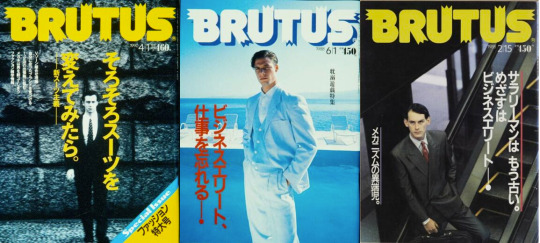

Brutus was originally a magazine for the post-Popeye generation: men who had graduated college and were now part of the workforce, a.k.a. "salarymen." The depiction of salarymen often has a depressing tone: faceless men in dark suits, overworked in bureaucratic, boring jobs, passed out on trains from exhaustion or drinking too much to cope with their burdening responsibilities. Not in early Brutus, where the portrayal of salarymen resembled how female fashion magazines characterize office ladies: young workers who should use their hard-earned financial independence to have fun and enjoy life.
With the bubble years as the backdrop, BRUTUS could convincingly sell the "salarymen" life as glamorous and a path to affluence. It told its readers to invest in expensive, glamorous suits; use their salary in fun ways, and leave the "salarymen" mindset behind, aiming instead to become a "business elite." A very 80s, optimistic way to see your career prospects, which would be much less convincing nowadays.


With the very generous budgets of the Bubble period, the magazine was known for travel-themed editions. The editors and the young staff would go on long trips to destinations perceived as "exotic" -- Africa, Vietnam, Thailand, China, South America, Cuba, Mexico -- and produce an entire issue around it.


Europe was also a popular destination for Brutus, with several issues exploring the continent and its culture. Decades before Scandinavian minimalism went mainstream, Brutus had an issue dedicated to the region's charms. Brutus highlighted East and West German culture. There were issues about traveling to Spain and Portugal, England, French culture and fashion…


But 80s Brutus had a particular obsession with Italy. Italian fashion, Italian "dolce vita," Italian cuisine, Italian design, and the charm and style of Italian men were thoroughly examined by the magazine.


US culture was the basis for Popeye. And while Brutus preferred to explore Europe in its first decade, it also had several issues dedicated to American culture and travel tips. Some of the themes were very "bubble year 80s," such as an issue advising readers to go skiing in Texas and another centered on buying real estate in Hawaii.


While the US often took a backseat to Europe, Brutus' favorite international city was New York City, as crystalized by two special mega-issues in 1982.


Popeye and Brutus explored many similar subjects: traveling, fashion, Tokyo city life, and where and what to buy. But 80s Brutus had something Popeye initially didn't: sex. A subject that completely matched Brutus's "pleasures of life" concept.
While "Hot Dog Press" had love manuals and sex guides for young teen boys (crucial for the magazine to surpass Popeye's sales), Brutus packaged that content in a more sophisticated, adult way. During the 80s, there were eight sex issues.


Regarding nudity, the 80s were very permissive compared to today's standards. While artistic shots of topless women on a magazine cover are unimaginable in 2022, '80s Brutus had several covers depicting nudity. In fact, its fifth-anniversary issue invited famed photographers to shoot nude pictorials. The edition was a hit, and the theme was repeated in other issues in the following years.


Brutus also had annual issues dedicated to architecture and interior design. It became such a standard Brutus topic that, in 1998, it spawned a spin-off title, "Casa Brutus."
But we're getting a little ahead of ourselves here. Going back to the 80s, it was the decade when the Popeye family grew exponentially.
One of the goals of Popeye magazine was to introduce Japanese youth to a more health-conscious lifestyle inspired by America. Besides sports, such as frisbee, skateboarding, and jogging, Popeye editors were fascinated by a concept that was somewhat foreign to Japan: muscle training. From the initial issue, the publication ran features on how to "shape up." Soon, Jiro Ishikawa started using another fictional character name to define the prototype of a muscular, fit guy: Tarzan.
The Tarzan lifestyle was particularly prominent in BRUTUS.

In 1985, for example, BRUTUS had an issue dedicated to the new "Tarzan era." Then, a few months later, in 1986, Tarzan became bi-weekly muscle training and fitness magazine, with Ishikawa as the founding editor. The first cover was shot by famed American photographer Reid Miles.
"Tarzan" is still in publication and is Japan's leading fitness publication.
But, of course, the Popeye family wouldn't be complete without Olive.
Olive magazine, aimed at the female public, was launched in 1982 as the "magazine for city girls." But it became a social phenomenon the following year when a female editor-in-chief took over and changed its entire concept. It wasn't solely the "female version of Popeye," but its own magazine, with a different vision: a dreamy, girly-like visual book aimed at teen girls. The "magazine for romantic girls" and its "lyceene" fashion were so influential that they'll be the theme of a future post. Despite its success in the 80s and 90s, "Olive" folded in 2000, the only one of the four spin-off titles that are not in circulation anymore.
23 notes
·
View notes
Text
A Budget Travel Guide to Backpacking in Europe
Are you an adventurous soul seeking to explore the beauty of Europe on a shoestring budget? Look no further! In this backpacking guide for beginners, we will unveil the secrets to experiencing the wonders of Europe without breaking the bank. From enchanting cities to picturesque landscapes, Europe has it all. So, grab your backpack and let's embark on an unforgettable journey!

The Best Hike in Washington, While backpacking in Europe, don't miss the opportunity to explore the breathtaking landscapes of Washington. The state boasts an array of scenic hiking trails, with the best hike being the majestic Wonderland Trail. Nestled in Mount Rainier National Park, this 93-mile trail offers awe-inspiring views of snow-capped mountains, pristine lakes, and abundant wildlife. It's an experience that will stay with you forever.

Europe offers a myriad of captivating destinations that won't drain your bank account. Consider starting your journey in Eastern Europe, where countries like Poland, Hungary, and the Czech Republic offer rich history, stunning architecture, and affordable prices. Other budget-friendly options include Portugal, Bulgaria, and Greece.
When exploring Europe, immerse yourself in local culture by trying street food and visiting local markets. Take advantage of free attractions, such as museums and parks, and explore lesser-known destinations off the beaten path. Remember to stay flexible with your itinerary, as unexpected opportunities may arise.
Conclusion:
Backpacking in Europe on a budget is an adventure like no other. By following this backpacking guide for beginners, you'll discover hidden gems, meet fellow travelers, and create lifelong memories without breaking the bank. So, get ready to embrace the thrill of backpacking and explore the enchanting wonders of Europe. Happy travels!
For more travel tips and inspiration, visit www.theeagertraveler.com

#backpacking guide for beginners#The Best Hike in Washington#Backpacking in Europe#Old Town and Gujarati Cuisine#Guide to Yosemite Firefall 2023#California Gold Country: A Road Trip Guide#Destination guide Santa Maria Valley#Destination guide Carmel#World travel guide#Thailand travel guide#Hiking adventures Washington#Best vacation destinations#Travel tips & recommendations#backpacking Southeast Asia#California adventure tips#Adventure travel blogs#Female travel bloggers#Travel photography blogs#Travel blog & adventure news#Budget travel guide Europe
0 notes
Text
In geopolitics, rarely do we realize that a tectonic shift is taking place the moment it is happening. There are a few exceptions: the Soviet Union’s launch of the world’s first space satellite, the fall of the Berlin Wall, and the 9/11 attacks. These moments were historical inflection points that were plain for all to see.
Russia’s war in Ukraine, which marks the return of naked, World War II-style aggression to Europe, is surely another such inflection point. But there is a second, less-noticed shift taking place right now that has at least as much power to alter history: the return of Japan as a major geopolitical actor. In the span of only one month from mid-December 2022 to mid-January of this year, Japan revised large parts of its post-1945 security posture and replaced it with a new strategy that—if implemented—would create a more robust and forward-leaning Japan. Tokyo’s policy shifts may signal a Japan that is not only more willing and capable of involving itself in geopolitical issues beyond its own narrow, defensive interests but also more likely to act in ways commensurate with its strategic position, regional interests, and economic might.
At the close of 2022, the administration of Japanese Prime Minister Fumio Kishida released three new strategic documents: a new National Security Strategy, National Defense Strategy, and Defense Buildup Plan. Then, in January, he and his foreign and defense ministers traveled to Washington to meet their U.S. counterparts. There, Japan’s new strategic thinking was on full display in joint statements with U.S. President Joe Biden as well as Defense Secretary Lloyd Austin and Secretary of State Antony Blinken. Among other changes, Tokyo has announced the intention to increase defense spending by nearly 60 percent over five years, abandoning an informal budget cap of 1 percent of GDP that was put in place for political purposes back in the 1970s. This alone represents an almost revolutionary departure from long-standing defense practices.
In addition to an array of sophisticated military equipment, Japan also seeks to acquire counterstrike missiles: long-range precision-guided munitions designed to deter an adversary’s attack, something Tokyo has historically eschewed. Other key changes include the creation of a permanent joint operational headquarters, the transfer of authority over the Japan Coast Guard to the Ministry of Defense during any conflict, the establishment of a robust cyberdefense, and a new commitment to intelligence capabilities.
Even more significant than specific capabilities, however, is Japan’s comprehensive expansion of its security interests beyond the defense of its own islands. With its lodestar of a free and open Indo-Pacific—on which Japan, as an island nation, crucially depends—Japan now freely talks about its interests in the South and East China Seas, the Pacific Islands, the Taiwan Strait, and as far away as Europe, with growing strategic partnerships with countries that see their interests tied to the same free and open seas. Whereas Japan once focused only on immediate self-defense, it is now taking a broader, more global view of its security across multiple regions. The result will be a Japan more deeply enmeshed in global security affairs, becoming less a beneficiary of security provided by others—chiefly the United States—and potentially more a security provider itself.
Even more remarkable is the fact that these changes have elicited such little opposition, either in Japan or in the region. When the United States and Japan were revising their security treaty in 1959 and 1960, there were hundreds of thousands of protesters in Japan’s streets. Even when the Shinzo Abe administration passed a package of security laws in 2015 that expanded the range of situations in which Tokyo can authorize the use of force and reinterpreted Japan’s right to engage in collective self-defense, there were considerable protests throughout Tokyo’s political district. This time? Not only are there no large-scale protests, but the debate has shifted from whether Japan should take these actions to how the country will pay for them. The Kishida administration is gifted with an issue on which it has so much support that it is pushing on an open door.
In the region, Japan’s new strategic posture has provoked little anxiety and few words of condemnation. Even in South Korea, which has been critical of Japanese defense efforts in the past, President Yoon Suk-yeol acknowledged that Japan’s moves—including acquiring counterstrike missiles—are understandable given North Korean threats. Beijing, unsurprisingly, said it was “firmly opposed” to and “strongly dissatisfied” with Japan’s new documents, accusing Tokyo of “[provoking] regional tension and confrontation.”
The motivation for Japan’s historic shift is twofold. The first is that Russia’s invasion of Ukraine suggests not only naked aggression is still possible in today’s globalized and integrated world but also that survival against a much larger neighbor depends on being well defended. The second, of course, is China’s approach to regional relations, which relies on bullying, provocation, coercion, and disrespect for international law, such as in the South and East China Seas. Japan has endured this behavior for years and finally appears to be fed up. When actions by Russia and China are viewed together, Japanese leaders and the country’s public are increasingly seeing conflict as an ever-present risk. As Kishida has said, “Ukraine may be the East Asia of tomorrow.” Japan might not be thinking that way if it were not for continuous provocations by China (and North Korea).
As promising as Japan’s actions appear, there are questions about actual implementation. Some steps are easier to predict than others: It is widely expected, for example, that Japan will continue to strengthen its quasi-alliance with Australia, likely through defense exercises, closer coordination of development assistance to Pacific Island nations, and strategic coordination in conjunction with the United States. But what about other partners in the region and beyond? Japan’s ties with South Korea appear, finally, to be improving. As long as the two countries keep World War II history from dominating their agenda, their common security concerns may allow Tokyo to work closer with Seoul on defense. Elsewhere, Japan’s first major defense export went to the Philippines, with which Japan also recently conducted its first-ever joint exercise. Given common security concerns over China, even closer security ties are likely in the years ahead. And given Japan’s view that European and Indo-Pacific security are linked, it is likely that Japan will continue to pursue closer ties with key European allies. Already, there is important movement, including an agreement that Japan will participate in NATO meetings on a regular basis as well as Japanese-British agreements on reciprocal access and the joint development of an advanced fighter jet.
Critical questions, however, remain. Japan pledges it will carry out “vigorous diplomacy” to foster a desirable security environment, but what will this look like? Will Japan push for greater leadership positions in international bodies? Will it get more involved in the global south? It is understandable that Japan is supporting Ukraine to push back against Russian aggression, but how far will Japanese support to Europe go? In Southeast Asia, where Japan historically has provided development assistance and security cooperation, Japan’s new strategy suggests it could take on more of a leadership position to help these smaller states push back against China. But how will this be implemented in practice? Similarly, how do Japan’s explicitly stated interests in the Taiwan Strait translate into what Japan is actually willing to do? If it comes to a Chinese attack, will Japan defend Taiwan? And finally, while plans to bolster the Japanese armed forces suggest a potentially more capable military, will challenges in resourcing and weapons development result in a less robust defense buildup?
None of this is meant to minimize the seriousness of Tokyo’s new policies or the historic change the world is witnessing. In very short order, Japan moved to change decades of strategic thinking and embark on a new approach to security. No one forced Japan to change: Washington did not coerce Tokyo into such a dramatic increase of its defense spending. The stark reality of geopolitics and the realization that what was once hypothetical is now possible were likely enough to convince Japan that the time for a new approach to its security is now.
9 notes
·
View notes
Text

Exploring Europe: A Guide to Your Next Adventure
Europe is a continent rich in history, culture, and natural beauty. From the romantic canals of Venice to the majestic fjords of Norway, Europe has something for everyone. In this post, we'll provide tips for planning your next European adventure.
Determine your budget: Europe can be an expensive destination, so it's important to determine your budget before you start planning. Consider the cost of flights, accommodations, food, and activities.
Choose your destinations: Europe is home to many diverse and exciting destinations. Consider visiting popular cities like Paris, Rome, and Barcelona, or explore the lesser-known gems like Prague, Bruges, and Salzburg.
Plan your transportation: Europe has an extensive transportation network that includes trains, buses, and low-cost airlines. Research your options and consider purchasing a Eurail pass or a city-to-city ticket for travel between countries.
Learn the language: While English is widely spoken in Europe, it's always helpful to learn a few key phrases in the local language. It shows respect for the culture and can make your interactions with locals more enjoyable.
Try the local cuisine: Europe is known for its delicious and diverse cuisine. From pasta in Italy to tapas in Spain, there's something for everyone. Be adventurous and try new dishes that are unique to the region you're visiting.
Experience the culture: Europe is home to some of the world's most iconic landmarks, museums, and galleries. Consider visiting the Eiffel Tower in Paris, the Colosseum in Rome, or the British Museum in London.
Europe is a diverse and exciting destination that offers something for every type of traveler. By following these tips, you can have a safe and enjoyable experience exploring all the continent has to offer.
3 notes
·
View notes
Text
Everything You Need to Know About Choosing Turkey Travel Packages
In the regional Turkish language, Turkey is often referred to as Türkiye. It is primarily found in Western Asia, in the Anatolian peninsula. Since one leg is connected to Europe and the other to Asia, it is also referred to as a bridge between the two continents. The Black Sea, Marmara Sea, Aegean Sea, and the Mediterranean Sea border the nation on three sides. It is the homeland of Turks who long ago migrated from Mongolia's interior. Iran, Iraq, Azerbaijan, Greece, Bulgaria, Georgia, Armenia, and Syria are all within modern Turkey's borders.
When it comes to the area, the Turkish race initially settled in western modern Turkey, where they went on to reside under the name Selcuk Beylics. The Osmanoullar community was established in the region where Bursa was the capital, some 4-5 hours' drive from Istanbul today, as a result of the separation of Selçuk Beylics into several groups over time. They transferred the capital from Bursa to Istanbul in later years. They lived through the golden eras when their borders stretched across tremendous periods. They eventually reached a point of stagnation and dissolution and handed the historical reins over to the Modern Turkish Republic.
Understanding Your Travel Style and Preferences
Understanding your travel tastes and style is the first step in selecting Turkey Holiday Packages. Think about the following:
Who are you as a traveller? Are you a daring backpacker or a pampered traveller seeking a more relaxing experience?
What do you find interesting? Do you favour outdoor pursuits like hiking and environmental exploration or are you more interested in history and culture?
What is your spending plan? What are your financial limits for a tour package?
What kind of transportation do you prefer? Would you like to take the bus, the train, or the aeroplane?
What kind of lodging do you prefer? Do you feel at ease staying in hostels or hotels, or do you like private lodging?
You can focus on tour packages that are suited to your needs by focusing on those that fit your travel interests and style.
Researching and Comparing Tour Options
Researching and contrasting tour choices is the next stage after you have a firm grasp of your travel interests and style. Here are a few pieces of advice:
Make use of reliable travel websites: Check out Turkey Holiday Packages from credible online sources as they offer testimonials and rankings from tourists who have taken the tours.
Visit the websites of the trip operators: The majority of tour operators have their websites where you may obtain details about the tours they provide, including itineraries, costs, and lodging choices.
Read Reviews: You may learn a lot about the tour's quality, the degree of customer care, and the entire experience from reviews written by other tourists.
Compare costs before choosing one product over another. Take into account the tour's overall worth and what is included in the cost. Some Turkey Travel Packages From India may appear more expensive, but they provide greater value for the money since they provide more activities or better accommodations.
Key Considerations for Choosing a Turkey Tour Package
There are numerous important factors to keep in mind when contrasting Turkey Travel Packages From India.
1. Itinerary: Finding a tour package that includes the locations and activities you are interested in is a good idea. Take into account the tour's duration and speed. Will you feel rushed or that you'll have plenty of time to visit each place?
2. Inclusions: Make sure you are aware of the tour package's inclusions. Does it include lodging, travel, meals, and entertainment? Do you need to budget for any additional fees or expenses?
3. Tour size: The magnitude of the excursion should be taken into consideration. Which do you prefer—a smaller, more private one or a bigger, more communal one?
4. Tour guide: Your trip can be greatly improved by a skilled and amiable tour guide. Make sure you check the tour guide's licence and read customer feedback.
Finding Turkey Travel Packages From India that allow you flexibility in terms of the schedule and activities is important. You will then have the option to go exploring on your own or to forego participating in activities that bore you.
Frequently Asked Questions
Q 1: Are private tours or group tours preferable for seeing Turkey?
A: That depends on what you desire. Private Turkey holiday packages from mumbai can be customised to your unique interests and demands, while group tours are typically less expensive and provide a social experience.
Q 2.Is travelling to Turkey safe?
A: Travellers can feel secure visiting Turkey. But you should always proceed with caution and pay attention to your surroundings.
Q3. When is the ideal time to travel to Turkey?
A: The months of April to May and September to November are ideal for travelling to Turkey because of the nice weather and reduced tourist traffic.
Q 4: Is a visa required to enter Turkey?
A: The majority of visitors do require visas to enter Turkey. You have two options for applying for a visa: online or at the airport.
Conclusion
Your travel interests, money, and style must all be carefully considered before selecting the ideal Turkey holiday packages from mumbai. You may choose wisely and have an unforgettable trip to Turkey by doing your homework, comparing your alternatives, and considering crucial factors like itinerary, inclusions, tour size, tour guide, and flexibility.
To make your tour the most suitable for you, don't forget to read reviews, ask questions, and don't be scared to customise it. Considering all there is to see and do in Turkey, picking the appropriate vacation package might be crucial. You won't regret it, so go ahead and reserve your ideal Turkey vacation package today!
3 notes
·
View notes
Text
Njoy Travels: Your Ultimate Guide to the Best International Tour Packages in India
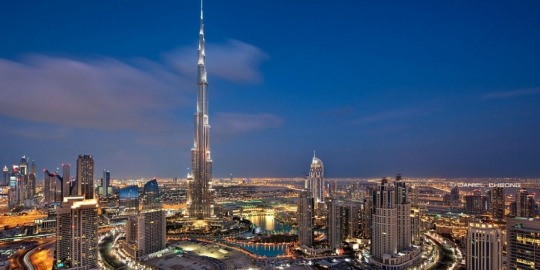
Njoy Travels is a renowned travel company based in India that offers a range of customized international tour packages for travelers. The company has been in the travel industry for several years, and over time, they have earned a reputation for providing excellent services and packages that cater to a wide range of travelers.
One of the reasons why Njoy Travels is regarded as one of the best international tour operators in India is their commitment to providing personalized services. They understand that each traveler is unique and has different preferences and requirements. Therefore, they offer tailored tour packages to suit the individual needs of their clients.
Njoy Travels offers a wide range of international tour packages to various destinations around the world, including Europe, Asia, Africa, Australia, North and South America. Their tour packages are carefully crafted to include the best tourist attractions, activities, and experiences that each destination has to offer. They also include accommodation, transportation, and meals, making it easier for travelers to plan and budget for their trips.
Another reason why Njoy Travels is highly regarded as an international tour operator is their experienced and knowledgeable tour guides. Their tour guides are well trained and have vast knowledge of the destinations they visit. They are also multilingual, making it easier for travelers to communicate and understand the local culture and customs.
Njoy Travels also places a high value on safety and security. They ensure that all their tour packages comply with safety standards and regulations. They also provide travel insurance to cover unexpected events that may occur during the trip.
Customer satisfaction is a top priority for Njoy Travels, and they strive to ensure that their clients have an unforgettable experience during their trips. They have a 24/7 customer support team that is always available to answer any questions or concerns that clients may have before, during, and after the trip.
In conclusion, Njoy Travels is one of the best international tour operators in India. Their commitment to providing personalized services, experienced tour guides, safety, and security, and excellent customer support makes them a preferred choice for many travelers. If you are looking for a hassle-free and unforgettable international travel experience, Njoy Travels is the way to go.
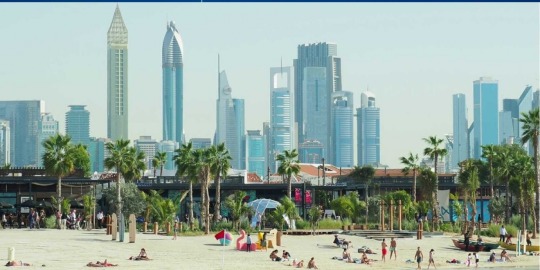
#travel#hotel room#transportation#photography#vehicle#best international tour operators in india#international tour#tour and travel#tour operator in india
2 notes
·
View notes